His past medical history consists of pneumonia
VerifiedAdded on 2022/08/21
|13
|3509
|11
AI Summary
Contribute Materials
Your contribution can guide someone’s learning journey. Share your
documents today.
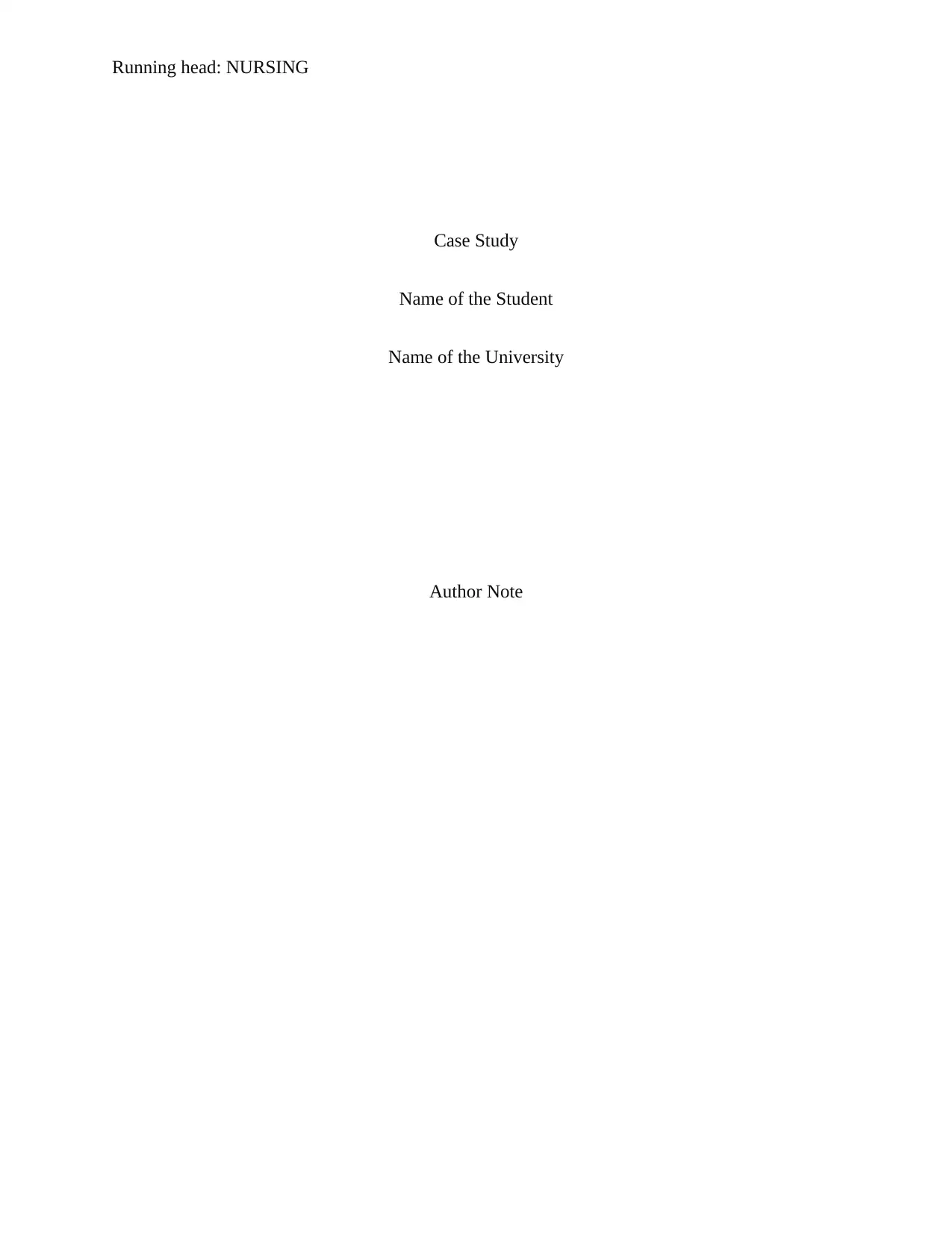
Running head: NURSING
Case Study
Name of the Student
Name of the University
Author Note
Case Study
Name of the Student
Name of the University
Author Note
Secure Best Marks with AI Grader
Need help grading? Try our AI Grader for instant feedback on your assignments.
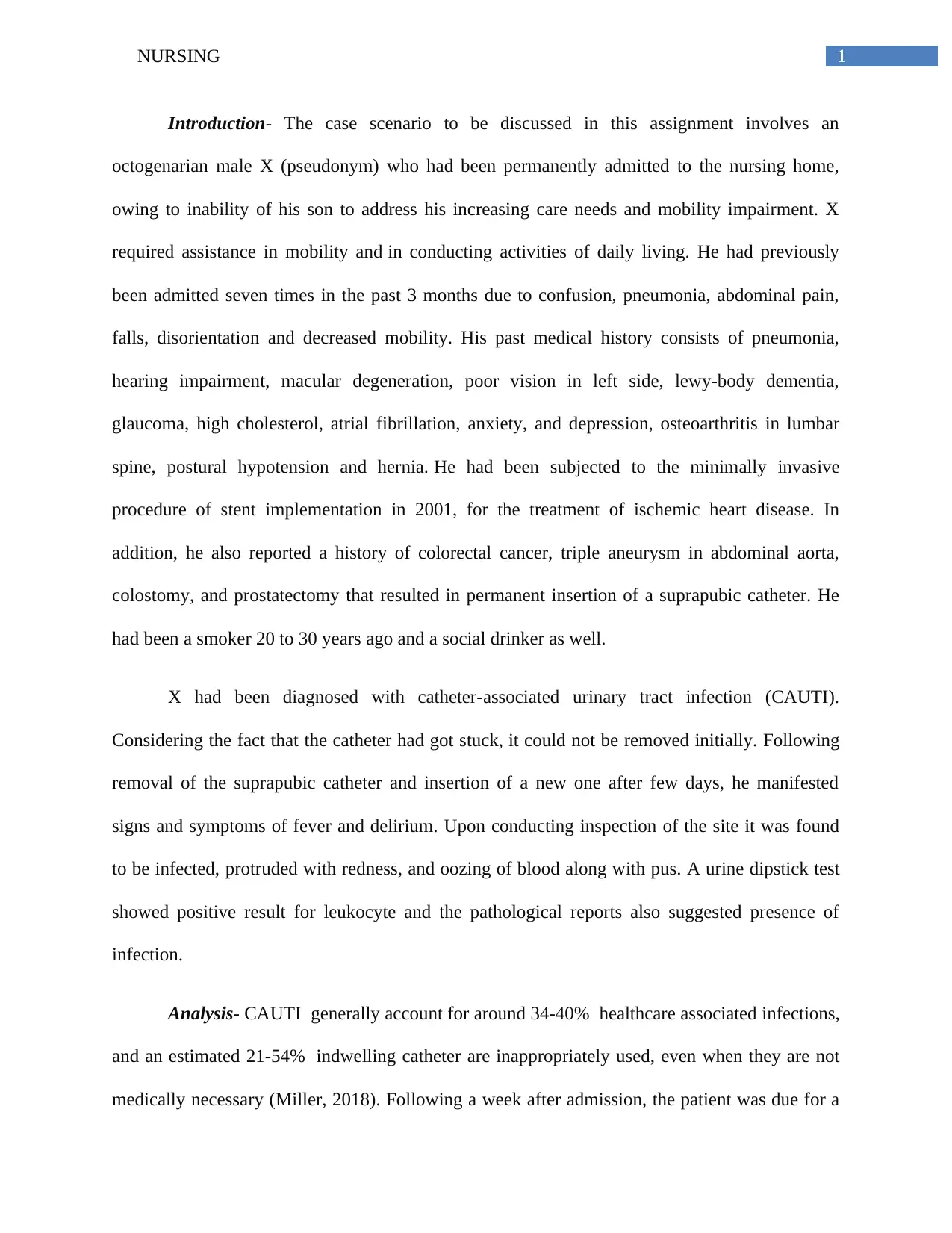
1NURSING
Introduction- The case scenario to be discussed in this assignment involves an
octogenarian male X (pseudonym) who had been permanently admitted to the nursing home,
owing to inability of his son to address his increasing care needs and mobility impairment. X
required assistance in mobility and in conducting activities of daily living. He had previously
been admitted seven times in the past 3 months due to confusion, pneumonia, abdominal pain,
falls, disorientation and decreased mobility. His past medical history consists of pneumonia,
hearing impairment, macular degeneration, poor vision in left side, lewy-body dementia,
glaucoma, high cholesterol, atrial fibrillation, anxiety, and depression, osteoarthritis in lumbar
spine, postural hypotension and hernia. He had been subjected to the minimally invasive
procedure of stent implementation in 2001, for the treatment of ischemic heart disease. In
addition, he also reported a history of colorectal cancer, triple aneurysm in abdominal aorta,
colostomy, and prostatectomy that resulted in permanent insertion of a suprapubic catheter. He
had been a smoker 20 to 30 years ago and a social drinker as well.
X had been diagnosed with catheter-associated urinary tract infection (CAUTI).
Considering the fact that the catheter had got stuck, it could not be removed initially. Following
removal of the suprapubic catheter and insertion of a new one after few days, he manifested
signs and symptoms of fever and delirium. Upon conducting inspection of the site it was found
to be infected, protruded with redness, and oozing of blood along with pus. A urine dipstick test
showed positive result for leukocyte and the pathological reports also suggested presence of
infection.
Analysis- CAUTI generally account for around 34-40% healthcare associated infections,
and an estimated 21-54% indwelling catheter are inappropriately used, even when they are not
medically necessary (Miller, 2018). Following a week after admission, the patient was due for a
Introduction- The case scenario to be discussed in this assignment involves an
octogenarian male X (pseudonym) who had been permanently admitted to the nursing home,
owing to inability of his son to address his increasing care needs and mobility impairment. X
required assistance in mobility and in conducting activities of daily living. He had previously
been admitted seven times in the past 3 months due to confusion, pneumonia, abdominal pain,
falls, disorientation and decreased mobility. His past medical history consists of pneumonia,
hearing impairment, macular degeneration, poor vision in left side, lewy-body dementia,
glaucoma, high cholesterol, atrial fibrillation, anxiety, and depression, osteoarthritis in lumbar
spine, postural hypotension and hernia. He had been subjected to the minimally invasive
procedure of stent implementation in 2001, for the treatment of ischemic heart disease. In
addition, he also reported a history of colorectal cancer, triple aneurysm in abdominal aorta,
colostomy, and prostatectomy that resulted in permanent insertion of a suprapubic catheter. He
had been a smoker 20 to 30 years ago and a social drinker as well.
X had been diagnosed with catheter-associated urinary tract infection (CAUTI).
Considering the fact that the catheter had got stuck, it could not be removed initially. Following
removal of the suprapubic catheter and insertion of a new one after few days, he manifested
signs and symptoms of fever and delirium. Upon conducting inspection of the site it was found
to be infected, protruded with redness, and oozing of blood along with pus. A urine dipstick test
showed positive result for leukocyte and the pathological reports also suggested presence of
infection.
Analysis- CAUTI generally account for around 34-40% healthcare associated infections,
and an estimated 21-54% indwelling catheter are inappropriately used, even when they are not
medically necessary (Miller, 2018). Following a week after admission, the patient was due for a
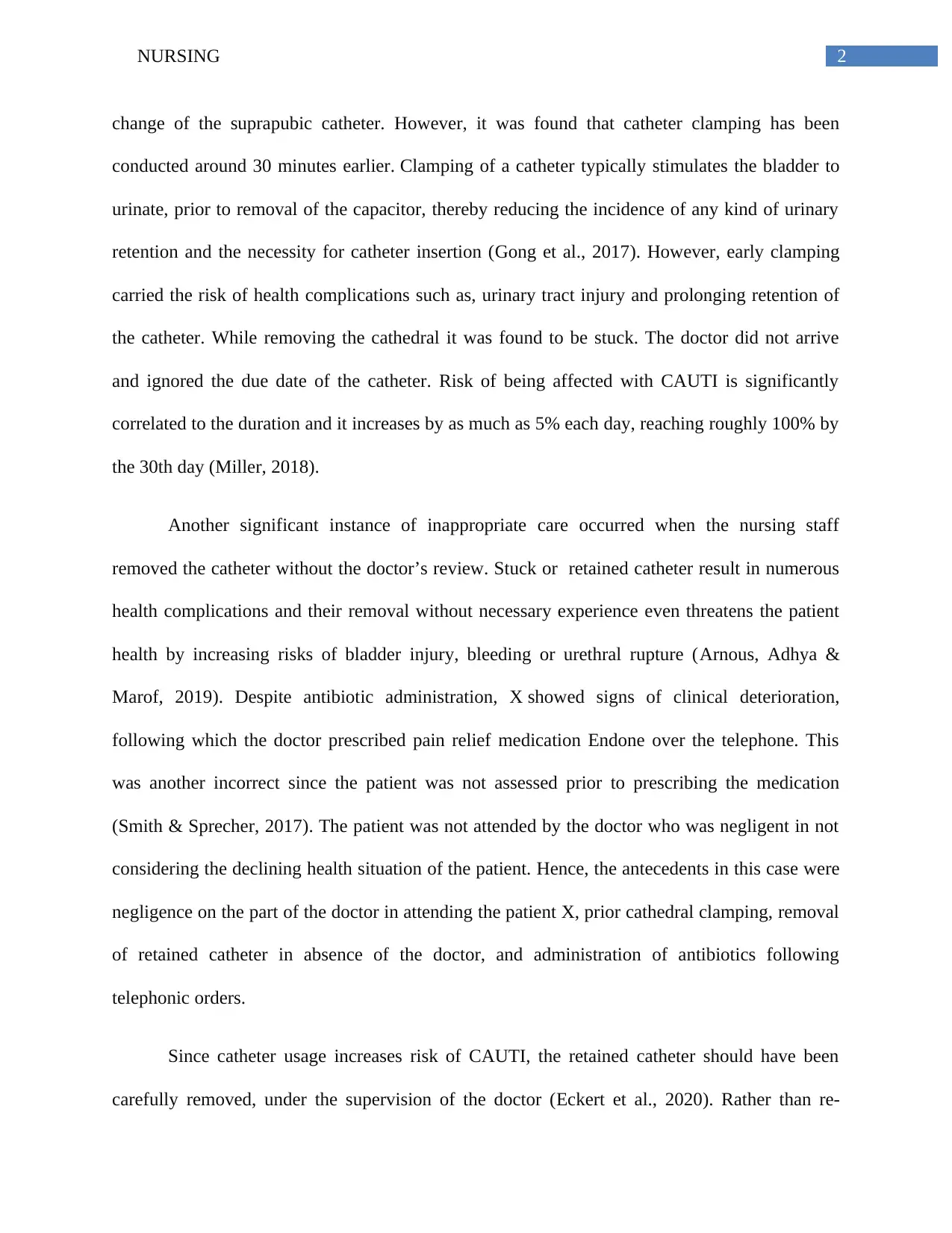
2NURSING
change of the suprapubic catheter. However, it was found that catheter clamping has been
conducted around 30 minutes earlier. Clamping of a catheter typically stimulates the bladder to
urinate, prior to removal of the capacitor, thereby reducing the incidence of any kind of urinary
retention and the necessity for catheter insertion (Gong et al., 2017). However, early clamping
carried the risk of health complications such as, urinary tract injury and prolonging retention of
the catheter. While removing the cathedral it was found to be stuck. The doctor did not arrive
and ignored the due date of the catheter. Risk of being affected with CAUTI is significantly
correlated to the duration and it increases by as much as 5% each day, reaching roughly 100% by
the 30th day (Miller, 2018).
Another significant instance of inappropriate care occurred when the nursing staff
removed the catheter without the doctor’s review. Stuck or retained catheter result in numerous
health complications and their removal without necessary experience even threatens the patient
health by increasing risks of bladder injury, bleeding or urethral rupture (Arnous, Adhya &
Marof, 2019). Despite antibiotic administration, X showed signs of clinical deterioration,
following which the doctor prescribed pain relief medication Endone over the telephone. This
was another incorrect since the patient was not assessed prior to prescribing the medication
(Smith & Sprecher, 2017). The patient was not attended by the doctor who was negligent in not
considering the declining health situation of the patient. Hence, the antecedents in this case were
negligence on the part of the doctor in attending the patient X, prior cathedral clamping, removal
of retained catheter in absence of the doctor, and administration of antibiotics following
telephonic orders.
Since catheter usage increases risk of CAUTI, the retained catheter should have been
carefully removed, under the supervision of the doctor (Eckert et al., 2020). Rather than re-
change of the suprapubic catheter. However, it was found that catheter clamping has been
conducted around 30 minutes earlier. Clamping of a catheter typically stimulates the bladder to
urinate, prior to removal of the capacitor, thereby reducing the incidence of any kind of urinary
retention and the necessity for catheter insertion (Gong et al., 2017). However, early clamping
carried the risk of health complications such as, urinary tract injury and prolonging retention of
the catheter. While removing the cathedral it was found to be stuck. The doctor did not arrive
and ignored the due date of the catheter. Risk of being affected with CAUTI is significantly
correlated to the duration and it increases by as much as 5% each day, reaching roughly 100% by
the 30th day (Miller, 2018).
Another significant instance of inappropriate care occurred when the nursing staff
removed the catheter without the doctor’s review. Stuck or retained catheter result in numerous
health complications and their removal without necessary experience even threatens the patient
health by increasing risks of bladder injury, bleeding or urethral rupture (Arnous, Adhya &
Marof, 2019). Despite antibiotic administration, X showed signs of clinical deterioration,
following which the doctor prescribed pain relief medication Endone over the telephone. This
was another incorrect since the patient was not assessed prior to prescribing the medication
(Smith & Sprecher, 2017). The patient was not attended by the doctor who was negligent in not
considering the declining health situation of the patient. Hence, the antecedents in this case were
negligence on the part of the doctor in attending the patient X, prior cathedral clamping, removal
of retained catheter in absence of the doctor, and administration of antibiotics following
telephonic orders.
Since catheter usage increases risk of CAUTI, the retained catheter should have been
carefully removed, under the supervision of the doctor (Eckert et al., 2020). Rather than re-
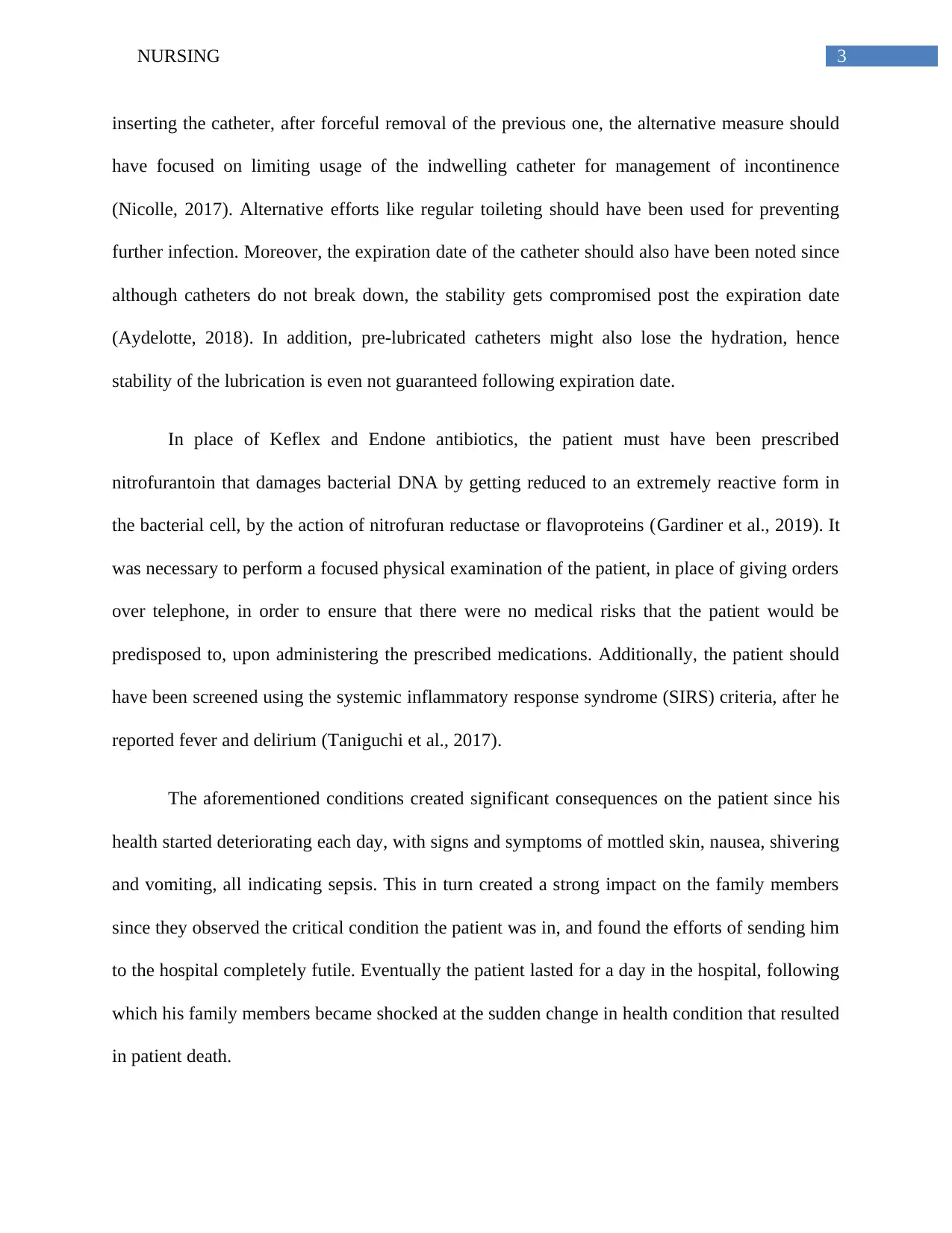
3NURSING
inserting the catheter, after forceful removal of the previous one, the alternative measure should
have focused on limiting usage of the indwelling catheter for management of incontinence
(Nicolle, 2017). Alternative efforts like regular toileting should have been used for preventing
further infection. Moreover, the expiration date of the catheter should also have been noted since
although catheters do not break down, the stability gets compromised post the expiration date
(Aydelotte, 2018). In addition, pre-lubricated catheters might also lose the hydration, hence
stability of the lubrication is even not guaranteed following expiration date.
In place of Keflex and Endone antibiotics, the patient must have been prescribed
nitrofurantoin that damages bacterial DNA by getting reduced to an extremely reactive form in
the bacterial cell, by the action of nitrofuran reductase or flavoproteins (Gardiner et al., 2019). It
was necessary to perform a focused physical examination of the patient, in place of giving orders
over telephone, in order to ensure that there were no medical risks that the patient would be
predisposed to, upon administering the prescribed medications. Additionally, the patient should
have been screened using the systemic inflammatory response syndrome (SIRS) criteria, after he
reported fever and delirium (Taniguchi et al., 2017).
The aforementioned conditions created significant consequences on the patient since his
health started deteriorating each day, with signs and symptoms of mottled skin, nausea, shivering
and vomiting, all indicating sepsis. This in turn created a strong impact on the family members
since they observed the critical condition the patient was in, and found the efforts of sending him
to the hospital completely futile. Eventually the patient lasted for a day in the hospital, following
which his family members became shocked at the sudden change in health condition that resulted
in patient death.
inserting the catheter, after forceful removal of the previous one, the alternative measure should
have focused on limiting usage of the indwelling catheter for management of incontinence
(Nicolle, 2017). Alternative efforts like regular toileting should have been used for preventing
further infection. Moreover, the expiration date of the catheter should also have been noted since
although catheters do not break down, the stability gets compromised post the expiration date
(Aydelotte, 2018). In addition, pre-lubricated catheters might also lose the hydration, hence
stability of the lubrication is even not guaranteed following expiration date.
In place of Keflex and Endone antibiotics, the patient must have been prescribed
nitrofurantoin that damages bacterial DNA by getting reduced to an extremely reactive form in
the bacterial cell, by the action of nitrofuran reductase or flavoproteins (Gardiner et al., 2019). It
was necessary to perform a focused physical examination of the patient, in place of giving orders
over telephone, in order to ensure that there were no medical risks that the patient would be
predisposed to, upon administering the prescribed medications. Additionally, the patient should
have been screened using the systemic inflammatory response syndrome (SIRS) criteria, after he
reported fever and delirium (Taniguchi et al., 2017).
The aforementioned conditions created significant consequences on the patient since his
health started deteriorating each day, with signs and symptoms of mottled skin, nausea, shivering
and vomiting, all indicating sepsis. This in turn created a strong impact on the family members
since they observed the critical condition the patient was in, and found the efforts of sending him
to the hospital completely futile. Eventually the patient lasted for a day in the hospital, following
which his family members became shocked at the sudden change in health condition that resulted
in patient death.
Secure Best Marks with AI Grader
Need help grading? Try our AI Grader for instant feedback on your assignments.
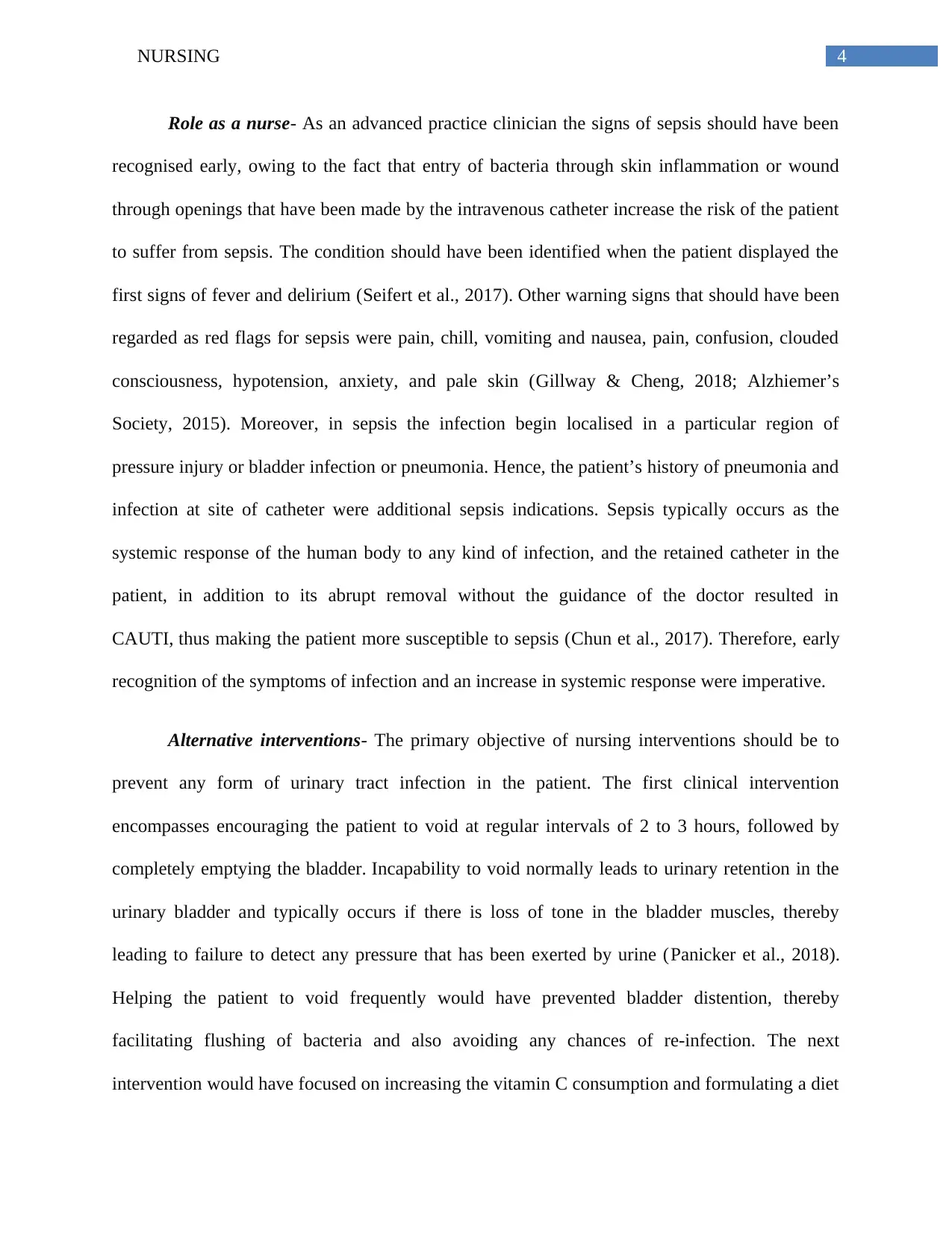
4NURSING
Role as a nurse- As an advanced practice clinician the signs of sepsis should have been
recognised early, owing to the fact that entry of bacteria through skin inflammation or wound
through openings that have been made by the intravenous catheter increase the risk of the patient
to suffer from sepsis. The condition should have been identified when the patient displayed the
first signs of fever and delirium (Seifert et al., 2017). Other warning signs that should have been
regarded as red flags for sepsis were pain, chill, vomiting and nausea, pain, confusion, clouded
consciousness, hypotension, anxiety, and pale skin (Gillway & Cheng, 2018; Alzhiemer’s
Society, 2015). Moreover, in sepsis the infection begin localised in a particular region of
pressure injury or bladder infection or pneumonia. Hence, the patient’s history of pneumonia and
infection at site of catheter were additional sepsis indications. Sepsis typically occurs as the
systemic response of the human body to any kind of infection, and the retained catheter in the
patient, in addition to its abrupt removal without the guidance of the doctor resulted in
CAUTI, thus making the patient more susceptible to sepsis (Chun et al., 2017). Therefore, early
recognition of the symptoms of infection and an increase in systemic response were imperative.
Alternative interventions- The primary objective of nursing interventions should be to
prevent any form of urinary tract infection in the patient. The first clinical intervention
encompasses encouraging the patient to void at regular intervals of 2 to 3 hours, followed by
completely emptying the bladder. Incapability to void normally leads to urinary retention in the
urinary bladder and typically occurs if there is loss of tone in the bladder muscles, thereby
leading to failure to detect any pressure that has been exerted by urine (Panicker et al., 2018).
Helping the patient to void frequently would have prevented bladder distention, thereby
facilitating flushing of bacteria and also avoiding any chances of re-infection. The next
intervention would have focused on increasing the vitamin C consumption and formulating a diet
Role as a nurse- As an advanced practice clinician the signs of sepsis should have been
recognised early, owing to the fact that entry of bacteria through skin inflammation or wound
through openings that have been made by the intravenous catheter increase the risk of the patient
to suffer from sepsis. The condition should have been identified when the patient displayed the
first signs of fever and delirium (Seifert et al., 2017). Other warning signs that should have been
regarded as red flags for sepsis were pain, chill, vomiting and nausea, pain, confusion, clouded
consciousness, hypotension, anxiety, and pale skin (Gillway & Cheng, 2018; Alzhiemer’s
Society, 2015). Moreover, in sepsis the infection begin localised in a particular region of
pressure injury or bladder infection or pneumonia. Hence, the patient’s history of pneumonia and
infection at site of catheter were additional sepsis indications. Sepsis typically occurs as the
systemic response of the human body to any kind of infection, and the retained catheter in the
patient, in addition to its abrupt removal without the guidance of the doctor resulted in
CAUTI, thus making the patient more susceptible to sepsis (Chun et al., 2017). Therefore, early
recognition of the symptoms of infection and an increase in systemic response were imperative.
Alternative interventions- The primary objective of nursing interventions should be to
prevent any form of urinary tract infection in the patient. The first clinical intervention
encompasses encouraging the patient to void at regular intervals of 2 to 3 hours, followed by
completely emptying the bladder. Incapability to void normally leads to urinary retention in the
urinary bladder and typically occurs if there is loss of tone in the bladder muscles, thereby
leading to failure to detect any pressure that has been exerted by urine (Panicker et al., 2018).
Helping the patient to void frequently would have prevented bladder distention, thereby
facilitating flushing of bacteria and also avoiding any chances of re-infection. The next
intervention would have focused on increasing the vitamin C consumption and formulating a diet
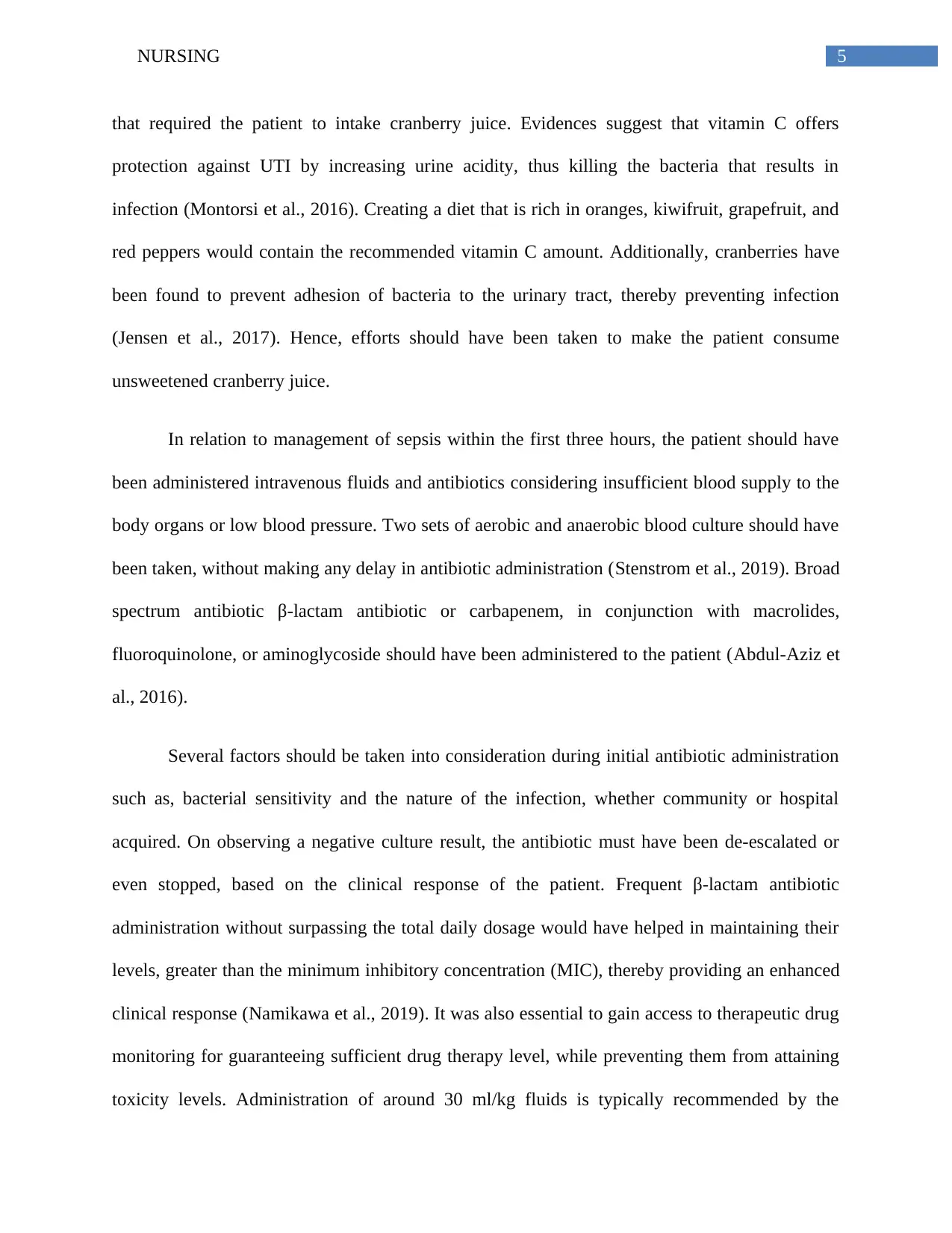
5NURSING
that required the patient to intake cranberry juice. Evidences suggest that vitamin C offers
protection against UTI by increasing urine acidity, thus killing the bacteria that results in
infection (Montorsi et al., 2016). Creating a diet that is rich in oranges, kiwifruit, grapefruit, and
red peppers would contain the recommended vitamin C amount. Additionally, cranberries have
been found to prevent adhesion of bacteria to the urinary tract, thereby preventing infection
(Jensen et al., 2017). Hence, efforts should have been taken to make the patient consume
unsweetened cranberry juice.
In relation to management of sepsis within the first three hours, the patient should have
been administered intravenous fluids and antibiotics considering insufficient blood supply to the
body organs or low blood pressure. Two sets of aerobic and anaerobic blood culture should have
been taken, without making any delay in antibiotic administration (Stenstrom et al., 2019). Broad
spectrum antibiotic β-lactam antibiotic or carbapenem, in conjunction with macrolides,
fluoroquinolone, or aminoglycoside should have been administered to the patient (Abdul-Aziz et
al., 2016).
Several factors should be taken into consideration during initial antibiotic administration
such as, bacterial sensitivity and the nature of the infection, whether community or hospital
acquired. On observing a negative culture result, the antibiotic must have been de-escalated or
even stopped, based on the clinical response of the patient. Frequent β-lactam antibiotic
administration without surpassing the total daily dosage would have helped in maintaining their
levels, greater than the minimum inhibitory concentration (MIC), thereby providing an enhanced
clinical response (Namikawa et al., 2019). It was also essential to gain access to therapeutic drug
monitoring for guaranteeing sufficient drug therapy level, while preventing them from attaining
toxicity levels. Administration of around 30 ml/kg fluids is typically recommended by the
that required the patient to intake cranberry juice. Evidences suggest that vitamin C offers
protection against UTI by increasing urine acidity, thus killing the bacteria that results in
infection (Montorsi et al., 2016). Creating a diet that is rich in oranges, kiwifruit, grapefruit, and
red peppers would contain the recommended vitamin C amount. Additionally, cranberries have
been found to prevent adhesion of bacteria to the urinary tract, thereby preventing infection
(Jensen et al., 2017). Hence, efforts should have been taken to make the patient consume
unsweetened cranberry juice.
In relation to management of sepsis within the first three hours, the patient should have
been administered intravenous fluids and antibiotics considering insufficient blood supply to the
body organs or low blood pressure. Two sets of aerobic and anaerobic blood culture should have
been taken, without making any delay in antibiotic administration (Stenstrom et al., 2019). Broad
spectrum antibiotic β-lactam antibiotic or carbapenem, in conjunction with macrolides,
fluoroquinolone, or aminoglycoside should have been administered to the patient (Abdul-Aziz et
al., 2016).
Several factors should be taken into consideration during initial antibiotic administration
such as, bacterial sensitivity and the nature of the infection, whether community or hospital
acquired. On observing a negative culture result, the antibiotic must have been de-escalated or
even stopped, based on the clinical response of the patient. Frequent β-lactam antibiotic
administration without surpassing the total daily dosage would have helped in maintaining their
levels, greater than the minimum inhibitory concentration (MIC), thereby providing an enhanced
clinical response (Namikawa et al., 2019). It was also essential to gain access to therapeutic drug
monitoring for guaranteeing sufficient drug therapy level, while preventing them from attaining
toxicity levels. Administration of around 30 ml/kg fluids is typically recommended by the
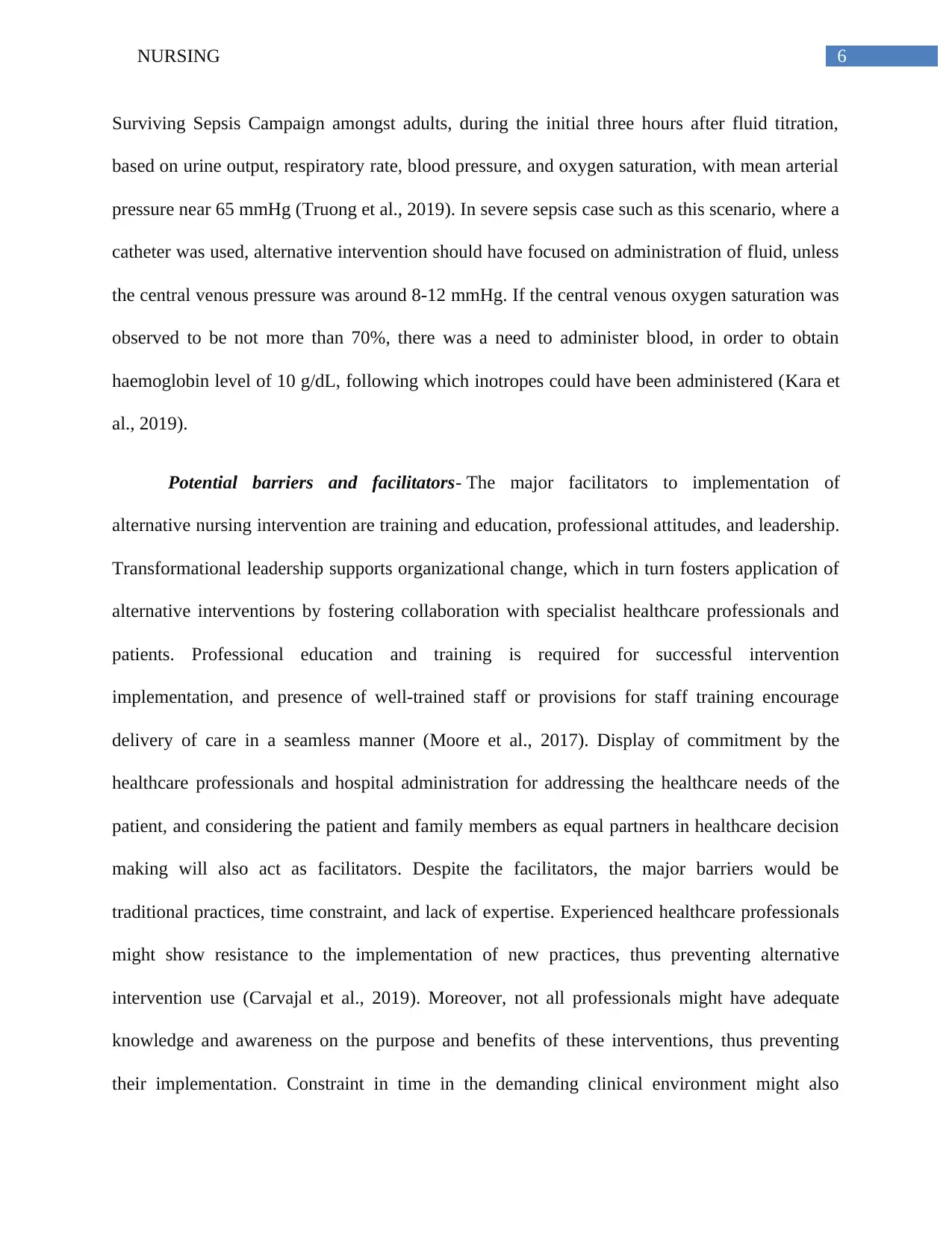
6NURSING
Surviving Sepsis Campaign amongst adults, during the initial three hours after fluid titration,
based on urine output, respiratory rate, blood pressure, and oxygen saturation, with mean arterial
pressure near 65 mmHg (Truong et al., 2019). In severe sepsis case such as this scenario, where a
catheter was used, alternative intervention should have focused on administration of fluid, unless
the central venous pressure was around 8-12 mmHg. If the central venous oxygen saturation was
observed to be not more than 70%, there was a need to administer blood, in order to obtain
haemoglobin level of 10 g/dL, following which inotropes could have been administered (Kara et
al., 2019).
Potential barriers and facilitators- The major facilitators to implementation of
alternative nursing intervention are training and education, professional attitudes, and leadership.
Transformational leadership supports organizational change, which in turn fosters application of
alternative interventions by fostering collaboration with specialist healthcare professionals and
patients. Professional education and training is required for successful intervention
implementation, and presence of well-trained staff or provisions for staff training encourage
delivery of care in a seamless manner (Moore et al., 2017). Display of commitment by the
healthcare professionals and hospital administration for addressing the healthcare needs of the
patient, and considering the patient and family members as equal partners in healthcare decision
making will also act as facilitators. Despite the facilitators, the major barriers would be
traditional practices, time constraint, and lack of expertise. Experienced healthcare professionals
might show resistance to the implementation of new practices, thus preventing alternative
intervention use (Carvajal et al., 2019). Moreover, not all professionals might have adequate
knowledge and awareness on the purpose and benefits of these interventions, thus preventing
their implementation. Constraint in time in the demanding clinical environment might also
Surviving Sepsis Campaign amongst adults, during the initial three hours after fluid titration,
based on urine output, respiratory rate, blood pressure, and oxygen saturation, with mean arterial
pressure near 65 mmHg (Truong et al., 2019). In severe sepsis case such as this scenario, where a
catheter was used, alternative intervention should have focused on administration of fluid, unless
the central venous pressure was around 8-12 mmHg. If the central venous oxygen saturation was
observed to be not more than 70%, there was a need to administer blood, in order to obtain
haemoglobin level of 10 g/dL, following which inotropes could have been administered (Kara et
al., 2019).
Potential barriers and facilitators- The major facilitators to implementation of
alternative nursing intervention are training and education, professional attitudes, and leadership.
Transformational leadership supports organizational change, which in turn fosters application of
alternative interventions by fostering collaboration with specialist healthcare professionals and
patients. Professional education and training is required for successful intervention
implementation, and presence of well-trained staff or provisions for staff training encourage
delivery of care in a seamless manner (Moore et al., 2017). Display of commitment by the
healthcare professionals and hospital administration for addressing the healthcare needs of the
patient, and considering the patient and family members as equal partners in healthcare decision
making will also act as facilitators. Despite the facilitators, the major barriers would be
traditional practices, time constraint, and lack of expertise. Experienced healthcare professionals
might show resistance to the implementation of new practices, thus preventing alternative
intervention use (Carvajal et al., 2019). Moreover, not all professionals might have adequate
knowledge and awareness on the purpose and benefits of these interventions, thus preventing
their implementation. Constraint in time in the demanding clinical environment might also
Paraphrase This Document
Need a fresh take? Get an instant paraphrase of this document with our AI Paraphraser
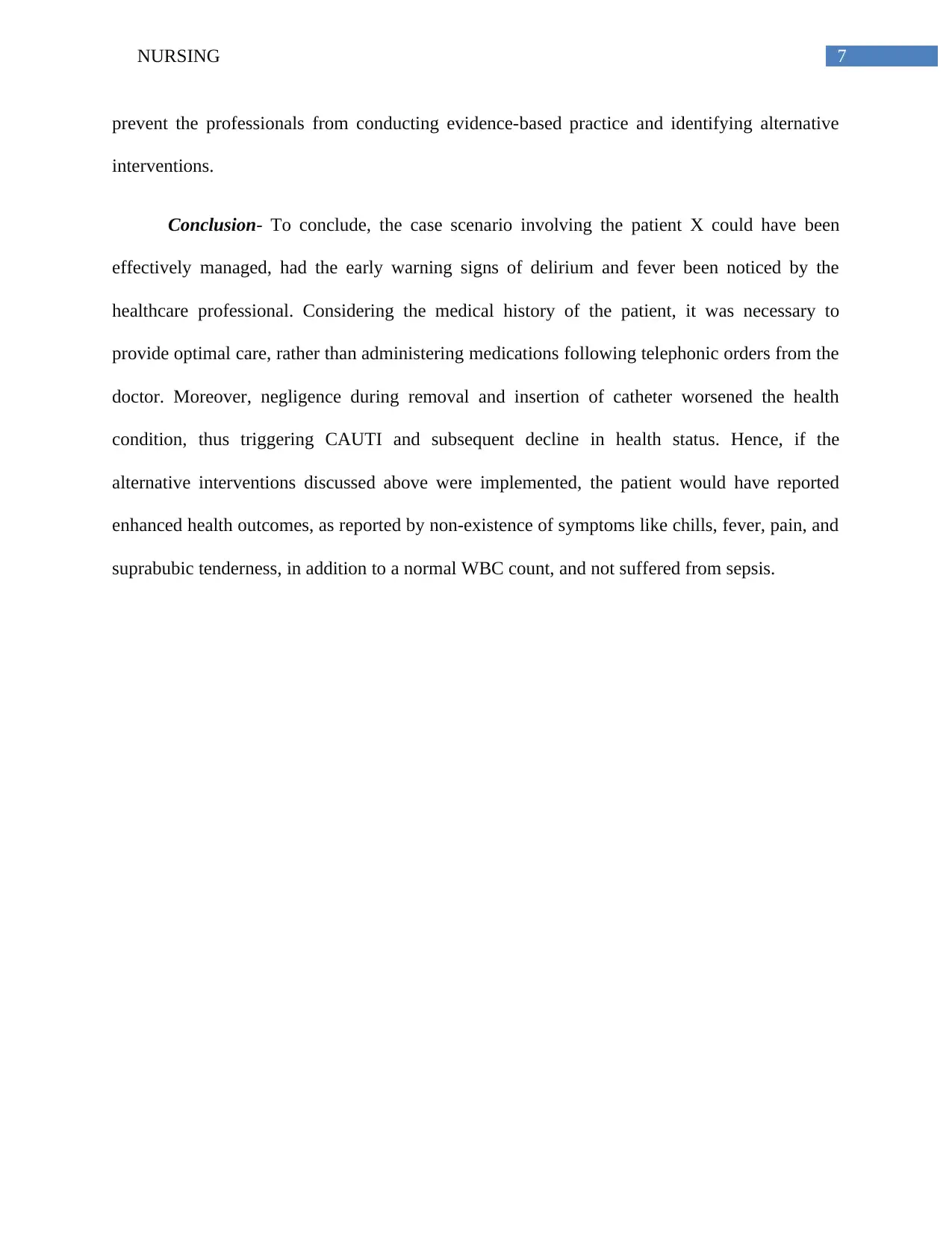
7NURSING
prevent the professionals from conducting evidence-based practice and identifying alternative
interventions.
Conclusion- To conclude, the case scenario involving the patient X could have been
effectively managed, had the early warning signs of delirium and fever been noticed by the
healthcare professional. Considering the medical history of the patient, it was necessary to
provide optimal care, rather than administering medications following telephonic orders from the
doctor. Moreover, negligence during removal and insertion of catheter worsened the health
condition, thus triggering CAUTI and subsequent decline in health status. Hence, if the
alternative interventions discussed above were implemented, the patient would have reported
enhanced health outcomes, as reported by non-existence of symptoms like chills, fever, pain, and
suprabubic tenderness, in addition to a normal WBC count, and not suffered from sepsis.
prevent the professionals from conducting evidence-based practice and identifying alternative
interventions.
Conclusion- To conclude, the case scenario involving the patient X could have been
effectively managed, had the early warning signs of delirium and fever been noticed by the
healthcare professional. Considering the medical history of the patient, it was necessary to
provide optimal care, rather than administering medications following telephonic orders from the
doctor. Moreover, negligence during removal and insertion of catheter worsened the health
condition, thus triggering CAUTI and subsequent decline in health status. Hence, if the
alternative interventions discussed above were implemented, the patient would have reported
enhanced health outcomes, as reported by non-existence of symptoms like chills, fever, pain, and
suprabubic tenderness, in addition to a normal WBC count, and not suffered from sepsis.
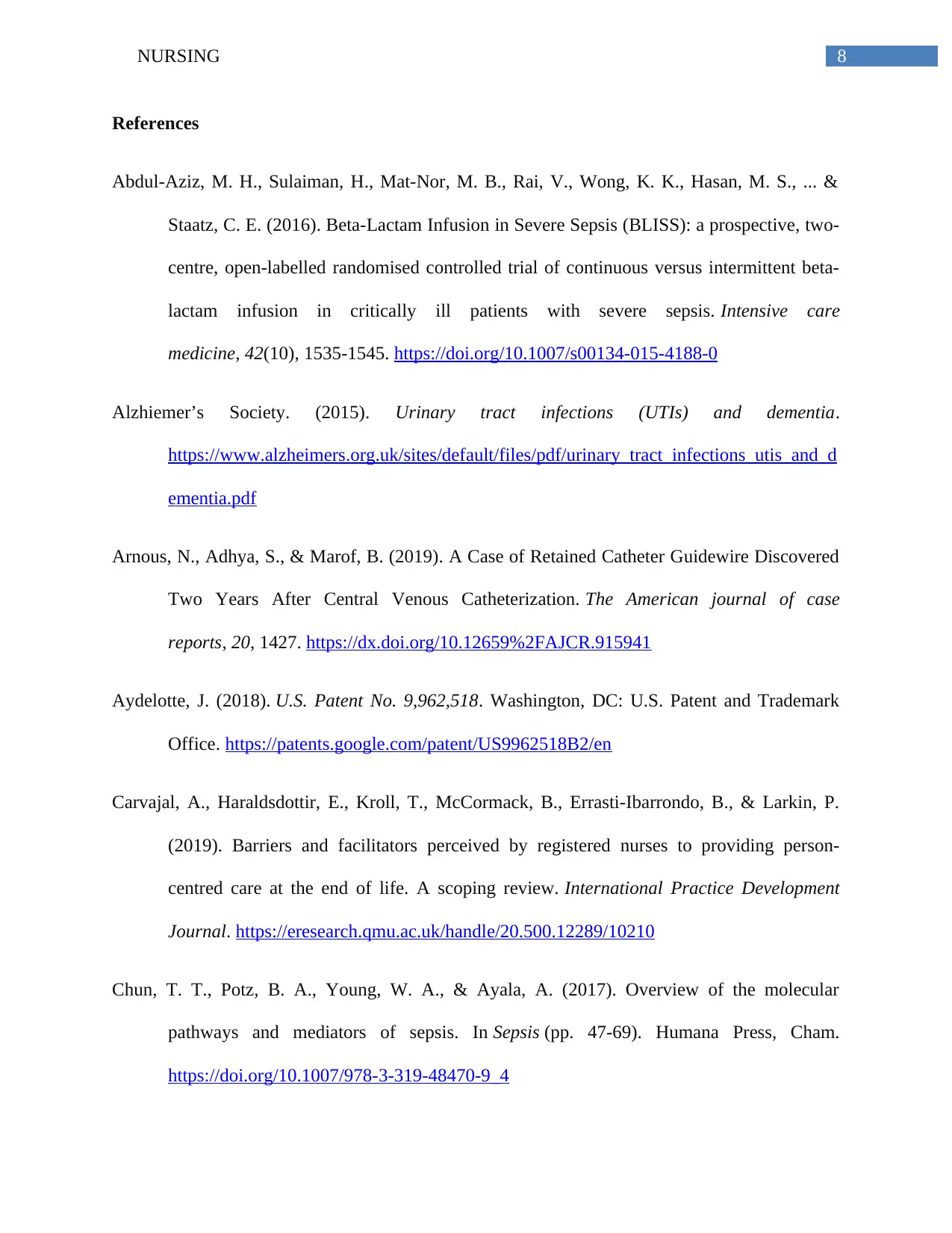
8NURSING
References
Abdul-Aziz, M. H., Sulaiman, H., Mat-Nor, M. B., Rai, V., Wong, K. K., Hasan, M. S., ... &
Staatz, C. E. (2016). Beta-Lactam Infusion in Severe Sepsis (BLISS): a prospective, two-
centre, open-labelled randomised controlled trial of continuous versus intermittent beta-
lactam infusion in critically ill patients with severe sepsis. Intensive care
medicine, 42(10), 1535-1545. https://doi.org/10.1007/s00134-015-4188-0
Alzhiemer’s Society. (2015). Urinary tract infections (UTIs) and dementia.
https://www.alzheimers.org.uk/sites/default/files/pdf/urinary_tract_infections_utis_and_d
ementia.pdf
Arnous, N., Adhya, S., & Marof, B. (2019). A Case of Retained Catheter Guidewire Discovered
Two Years After Central Venous Catheterization. The American journal of case
reports, 20, 1427. https://dx.doi.org/10.12659%2FAJCR.915941
Aydelotte, J. (2018). U.S. Patent No. 9,962,518. Washington, DC: U.S. Patent and Trademark
Office. https://patents.google.com/patent/US9962518B2/en
Carvajal, A., Haraldsdottir, E., Kroll, T., McCormack, B., Errasti-Ibarrondo, B., & Larkin, P.
(2019). Barriers and facilitators perceived by registered nurses to providing person-
centred care at the end of life. A scoping review. International Practice Development
Journal. https://eresearch.qmu.ac.uk/handle/20.500.12289/10210
Chun, T. T., Potz, B. A., Young, W. A., & Ayala, A. (2017). Overview of the molecular
pathways and mediators of sepsis. In Sepsis (pp. 47-69). Humana Press, Cham.
https://doi.org/10.1007/978-3-319-48470-9_4
References
Abdul-Aziz, M. H., Sulaiman, H., Mat-Nor, M. B., Rai, V., Wong, K. K., Hasan, M. S., ... &
Staatz, C. E. (2016). Beta-Lactam Infusion in Severe Sepsis (BLISS): a prospective, two-
centre, open-labelled randomised controlled trial of continuous versus intermittent beta-
lactam infusion in critically ill patients with severe sepsis. Intensive care
medicine, 42(10), 1535-1545. https://doi.org/10.1007/s00134-015-4188-0
Alzhiemer’s Society. (2015). Urinary tract infections (UTIs) and dementia.
https://www.alzheimers.org.uk/sites/default/files/pdf/urinary_tract_infections_utis_and_d
ementia.pdf
Arnous, N., Adhya, S., & Marof, B. (2019). A Case of Retained Catheter Guidewire Discovered
Two Years After Central Venous Catheterization. The American journal of case
reports, 20, 1427. https://dx.doi.org/10.12659%2FAJCR.915941
Aydelotte, J. (2018). U.S. Patent No. 9,962,518. Washington, DC: U.S. Patent and Trademark
Office. https://patents.google.com/patent/US9962518B2/en
Carvajal, A., Haraldsdottir, E., Kroll, T., McCormack, B., Errasti-Ibarrondo, B., & Larkin, P.
(2019). Barriers and facilitators perceived by registered nurses to providing person-
centred care at the end of life. A scoping review. International Practice Development
Journal. https://eresearch.qmu.ac.uk/handle/20.500.12289/10210
Chun, T. T., Potz, B. A., Young, W. A., & Ayala, A. (2017). Overview of the molecular
pathways and mediators of sepsis. In Sepsis (pp. 47-69). Humana Press, Cham.
https://doi.org/10.1007/978-3-319-48470-9_4
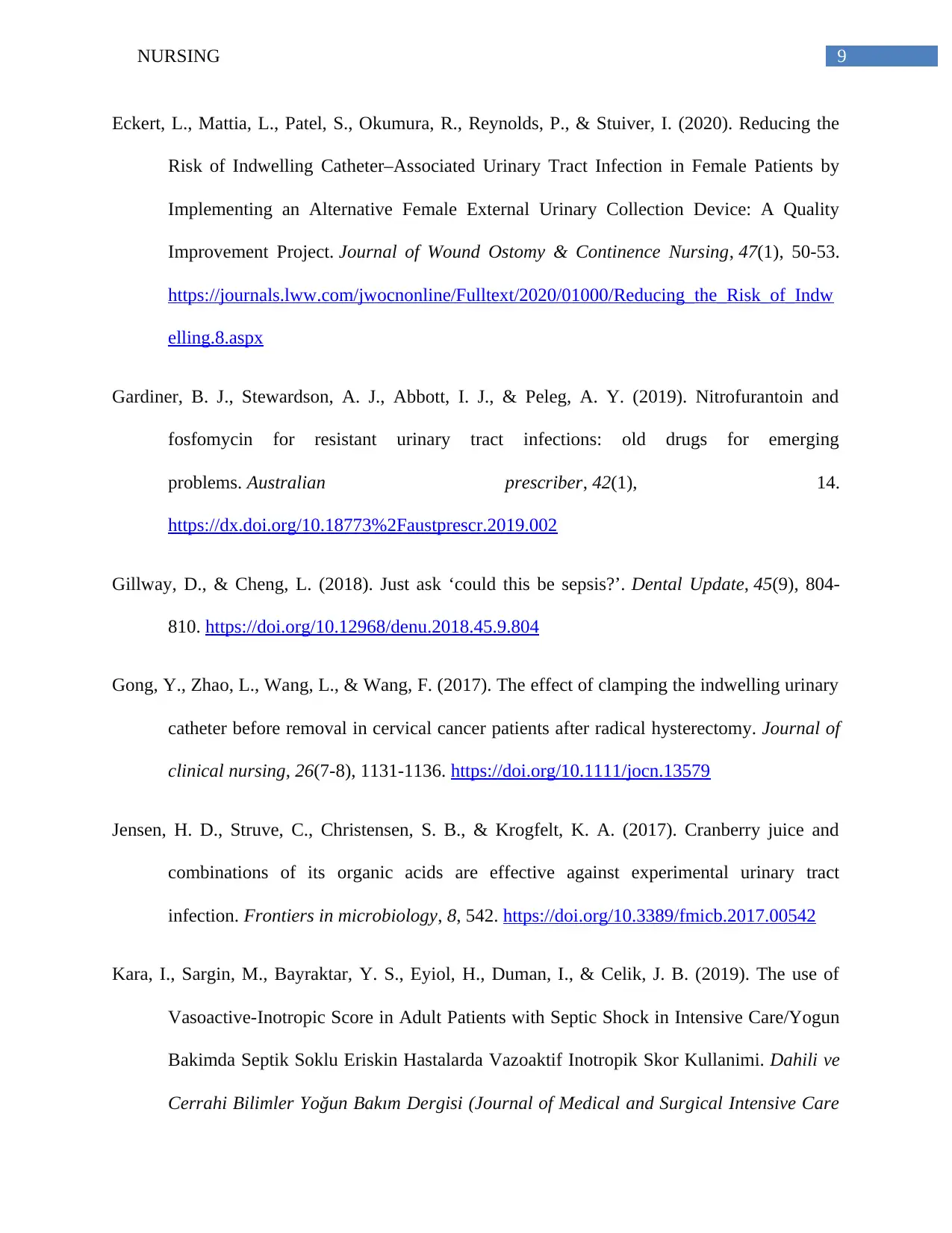
9NURSING
Eckert, L., Mattia, L., Patel, S., Okumura, R., Reynolds, P., & Stuiver, I. (2020). Reducing the
Risk of Indwelling Catheter–Associated Urinary Tract Infection in Female Patients by
Implementing an Alternative Female External Urinary Collection Device: A Quality
Improvement Project. Journal of Wound Ostomy & Continence Nursing, 47(1), 50-53.
https://journals.lww.com/jwocnonline/Fulltext/2020/01000/Reducing_the_Risk_of_Indw
elling.8.aspx
Gardiner, B. J., Stewardson, A. J., Abbott, I. J., & Peleg, A. Y. (2019). Nitrofurantoin and
fosfomycin for resistant urinary tract infections: old drugs for emerging
problems. Australian prescriber, 42(1), 14.
https://dx.doi.org/10.18773%2Faustprescr.2019.002
Gillway, D., & Cheng, L. (2018). Just ask ‘could this be sepsis?’. Dental Update, 45(9), 804-
810. https://doi.org/10.12968/denu.2018.45.9.804
Gong, Y., Zhao, L., Wang, L., & Wang, F. (2017). The effect of clamping the indwelling urinary
catheter before removal in cervical cancer patients after radical hysterectomy. Journal of
clinical nursing, 26(7-8), 1131-1136. https://doi.org/10.1111/jocn.13579
Jensen, H. D., Struve, C., Christensen, S. B., & Krogfelt, K. A. (2017). Cranberry juice and
combinations of its organic acids are effective against experimental urinary tract
infection. Frontiers in microbiology, 8, 542. https://doi.org/10.3389/fmicb.2017.00542
Kara, I., Sargin, M., Bayraktar, Y. S., Eyiol, H., Duman, I., & Celik, J. B. (2019). The use of
Vasoactive-Inotropic Score in Adult Patients with Septic Shock in Intensive Care/Yogun
Bakimda Septik Soklu Eriskin Hastalarda Vazoaktif Inotropik Skor Kullanimi. Dahili ve
Cerrahi Bilimler Yoğun Bakım Dergisi (Journal of Medical and Surgical Intensive Care
Eckert, L., Mattia, L., Patel, S., Okumura, R., Reynolds, P., & Stuiver, I. (2020). Reducing the
Risk of Indwelling Catheter–Associated Urinary Tract Infection in Female Patients by
Implementing an Alternative Female External Urinary Collection Device: A Quality
Improvement Project. Journal of Wound Ostomy & Continence Nursing, 47(1), 50-53.
https://journals.lww.com/jwocnonline/Fulltext/2020/01000/Reducing_the_Risk_of_Indw
elling.8.aspx
Gardiner, B. J., Stewardson, A. J., Abbott, I. J., & Peleg, A. Y. (2019). Nitrofurantoin and
fosfomycin for resistant urinary tract infections: old drugs for emerging
problems. Australian prescriber, 42(1), 14.
https://dx.doi.org/10.18773%2Faustprescr.2019.002
Gillway, D., & Cheng, L. (2018). Just ask ‘could this be sepsis?’. Dental Update, 45(9), 804-
810. https://doi.org/10.12968/denu.2018.45.9.804
Gong, Y., Zhao, L., Wang, L., & Wang, F. (2017). The effect of clamping the indwelling urinary
catheter before removal in cervical cancer patients after radical hysterectomy. Journal of
clinical nursing, 26(7-8), 1131-1136. https://doi.org/10.1111/jocn.13579
Jensen, H. D., Struve, C., Christensen, S. B., & Krogfelt, K. A. (2017). Cranberry juice and
combinations of its organic acids are effective against experimental urinary tract
infection. Frontiers in microbiology, 8, 542. https://doi.org/10.3389/fmicb.2017.00542
Kara, I., Sargin, M., Bayraktar, Y. S., Eyiol, H., Duman, I., & Celik, J. B. (2019). The use of
Vasoactive-Inotropic Score in Adult Patients with Septic Shock in Intensive Care/Yogun
Bakimda Septik Soklu Eriskin Hastalarda Vazoaktif Inotropik Skor Kullanimi. Dahili ve
Cerrahi Bilimler Yoğun Bakım Dergisi (Journal of Medical and Surgical Intensive Care
Secure Best Marks with AI Grader
Need help grading? Try our AI Grader for instant feedback on your assignments.
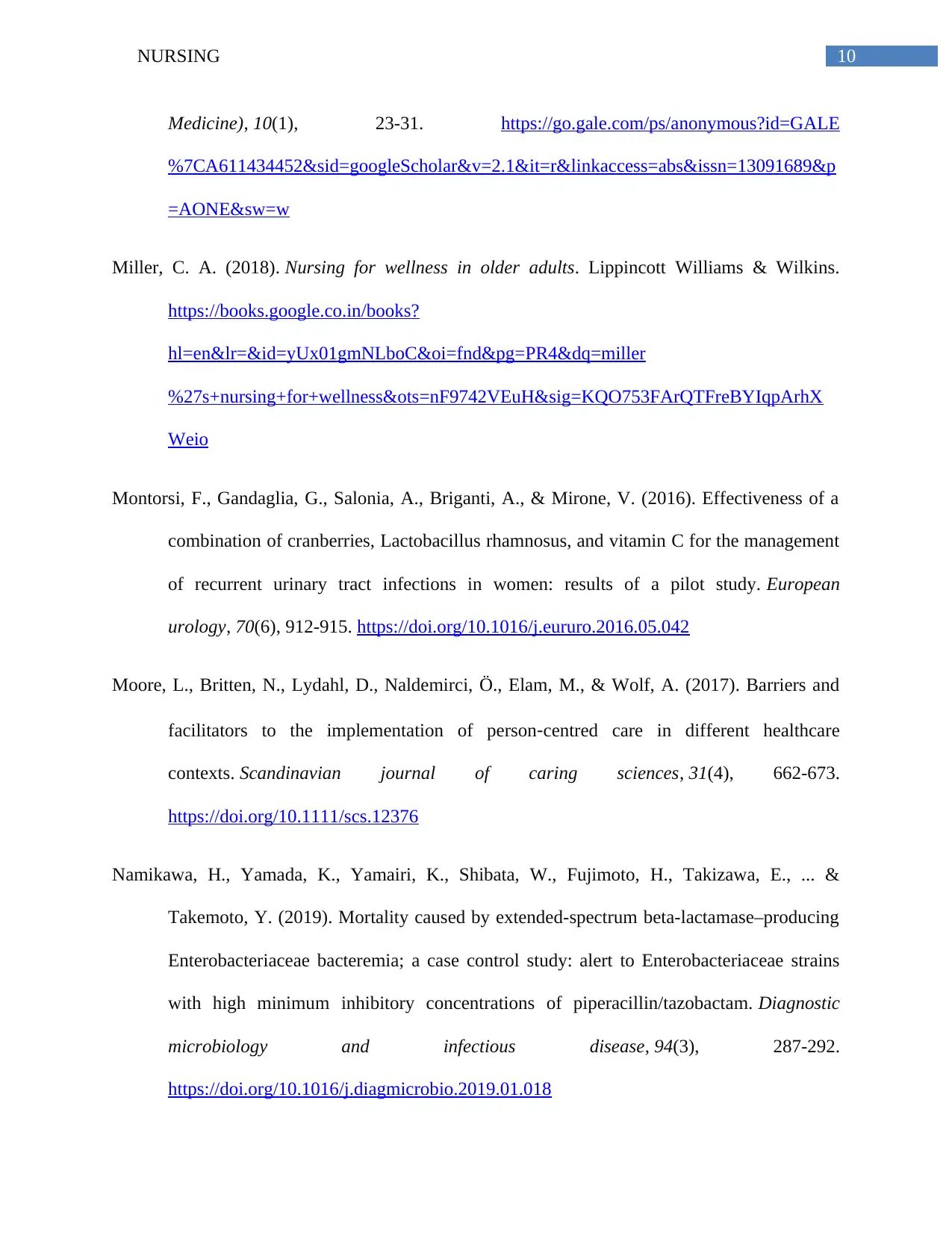
10NURSING
Medicine), 10(1), 23-31. https://go.gale.com/ps/anonymous?id=GALE
%7CA611434452&sid=googleScholar&v=2.1&it=r&linkaccess=abs&issn=13091689&p
=AONE&sw=w
Miller, C. A. (2018). Nursing for wellness in older adults. Lippincott Williams & Wilkins.
https://books.google.co.in/books?
hl=en&lr=&id=yUx01gmNLboC&oi=fnd&pg=PR4&dq=miller
%27s+nursing+for+wellness&ots=nF9742VEuH&sig=KQO753FArQTFreBYIqpArhX
Weio
Montorsi, F., Gandaglia, G., Salonia, A., Briganti, A., & Mirone, V. (2016). Effectiveness of a
combination of cranberries, Lactobacillus rhamnosus, and vitamin C for the management
of recurrent urinary tract infections in women: results of a pilot study. European
urology, 70(6), 912-915. https://doi.org/10.1016/j.eururo.2016.05.042
Moore, L., Britten, N., Lydahl, D., Naldemirci, Ö., Elam, M., & Wolf, A. (2017). Barriers and
facilitators to the implementation of person‐centred care in different healthcare
contexts. Scandinavian journal of caring sciences, 31(4), 662-673.
https://doi.org/10.1111/scs.12376
Namikawa, H., Yamada, K., Yamairi, K., Shibata, W., Fujimoto, H., Takizawa, E., ... &
Takemoto, Y. (2019). Mortality caused by extended-spectrum beta-lactamase–producing
Enterobacteriaceae bacteremia; a case control study: alert to Enterobacteriaceae strains
with high minimum inhibitory concentrations of piperacillin/tazobactam. Diagnostic
microbiology and infectious disease, 94(3), 287-292.
https://doi.org/10.1016/j.diagmicrobio.2019.01.018
Medicine), 10(1), 23-31. https://go.gale.com/ps/anonymous?id=GALE
%7CA611434452&sid=googleScholar&v=2.1&it=r&linkaccess=abs&issn=13091689&p
=AONE&sw=w
Miller, C. A. (2018). Nursing for wellness in older adults. Lippincott Williams & Wilkins.
https://books.google.co.in/books?
hl=en&lr=&id=yUx01gmNLboC&oi=fnd&pg=PR4&dq=miller
%27s+nursing+for+wellness&ots=nF9742VEuH&sig=KQO753FArQTFreBYIqpArhX
Weio
Montorsi, F., Gandaglia, G., Salonia, A., Briganti, A., & Mirone, V. (2016). Effectiveness of a
combination of cranberries, Lactobacillus rhamnosus, and vitamin C for the management
of recurrent urinary tract infections in women: results of a pilot study. European
urology, 70(6), 912-915. https://doi.org/10.1016/j.eururo.2016.05.042
Moore, L., Britten, N., Lydahl, D., Naldemirci, Ö., Elam, M., & Wolf, A. (2017). Barriers and
facilitators to the implementation of person‐centred care in different healthcare
contexts. Scandinavian journal of caring sciences, 31(4), 662-673.
https://doi.org/10.1111/scs.12376
Namikawa, H., Yamada, K., Yamairi, K., Shibata, W., Fujimoto, H., Takizawa, E., ... &
Takemoto, Y. (2019). Mortality caused by extended-spectrum beta-lactamase–producing
Enterobacteriaceae bacteremia; a case control study: alert to Enterobacteriaceae strains
with high minimum inhibitory concentrations of piperacillin/tazobactam. Diagnostic
microbiology and infectious disease, 94(3), 287-292.
https://doi.org/10.1016/j.diagmicrobio.2019.01.018
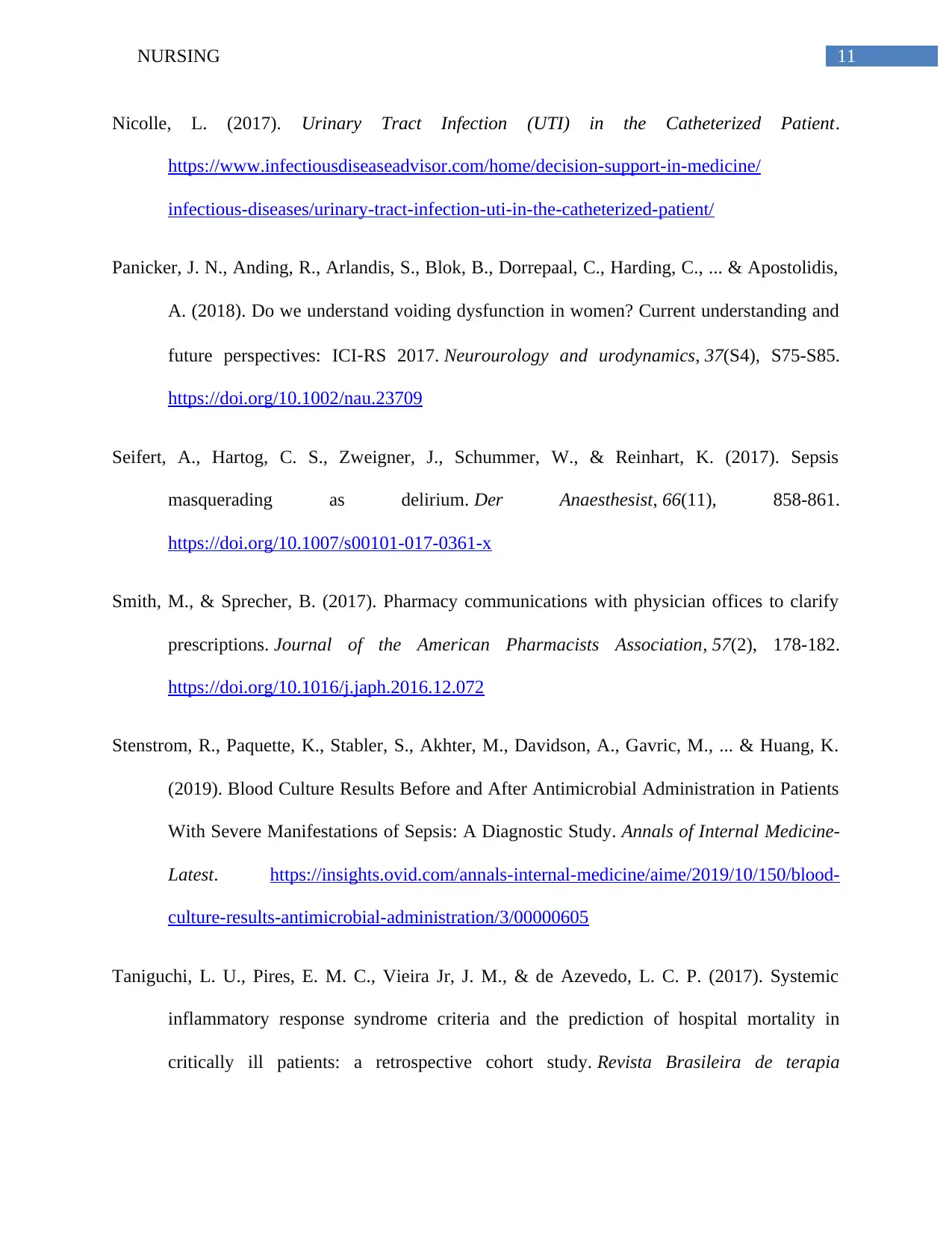
11NURSING
Nicolle, L. (2017). Urinary Tract Infection (UTI) in the Catheterized Patient.
https://www.infectiousdiseaseadvisor.com/home/decision-support-in-medicine/
infectious-diseases/urinary-tract-infection-uti-in-the-catheterized-patient/
Panicker, J. N., Anding, R., Arlandis, S., Blok, B., Dorrepaal, C., Harding, C., ... & Apostolidis,
A. (2018). Do we understand voiding dysfunction in women? Current understanding and
future perspectives: ICI‐RS 2017. Neurourology and urodynamics, 37(S4), S75-S85.
https://doi.org/10.1002/nau.23709
Seifert, A., Hartog, C. S., Zweigner, J., Schummer, W., & Reinhart, K. (2017). Sepsis
masquerading as delirium. Der Anaesthesist, 66(11), 858-861.
https://doi.org/10.1007/s00101-017-0361-x
Smith, M., & Sprecher, B. (2017). Pharmacy communications with physician offices to clarify
prescriptions. Journal of the American Pharmacists Association, 57(2), 178-182.
https://doi.org/10.1016/j.japh.2016.12.072
Stenstrom, R., Paquette, K., Stabler, S., Akhter, M., Davidson, A., Gavric, M., ... & Huang, K.
(2019). Blood Culture Results Before and After Antimicrobial Administration in Patients
With Severe Manifestations of Sepsis: A Diagnostic Study. Annals of Internal Medicine-
Latest. https://insights.ovid.com/annals-internal-medicine/aime/2019/10/150/blood-
culture-results-antimicrobial-administration/3/00000605
Taniguchi, L. U., Pires, E. M. C., Vieira Jr, J. M., & de Azevedo, L. C. P. (2017). Systemic
inflammatory response syndrome criteria and the prediction of hospital mortality in
critically ill patients: a retrospective cohort study. Revista Brasileira de terapia
Nicolle, L. (2017). Urinary Tract Infection (UTI) in the Catheterized Patient.
https://www.infectiousdiseaseadvisor.com/home/decision-support-in-medicine/
infectious-diseases/urinary-tract-infection-uti-in-the-catheterized-patient/
Panicker, J. N., Anding, R., Arlandis, S., Blok, B., Dorrepaal, C., Harding, C., ... & Apostolidis,
A. (2018). Do we understand voiding dysfunction in women? Current understanding and
future perspectives: ICI‐RS 2017. Neurourology and urodynamics, 37(S4), S75-S85.
https://doi.org/10.1002/nau.23709
Seifert, A., Hartog, C. S., Zweigner, J., Schummer, W., & Reinhart, K. (2017). Sepsis
masquerading as delirium. Der Anaesthesist, 66(11), 858-861.
https://doi.org/10.1007/s00101-017-0361-x
Smith, M., & Sprecher, B. (2017). Pharmacy communications with physician offices to clarify
prescriptions. Journal of the American Pharmacists Association, 57(2), 178-182.
https://doi.org/10.1016/j.japh.2016.12.072
Stenstrom, R., Paquette, K., Stabler, S., Akhter, M., Davidson, A., Gavric, M., ... & Huang, K.
(2019). Blood Culture Results Before and After Antimicrobial Administration in Patients
With Severe Manifestations of Sepsis: A Diagnostic Study. Annals of Internal Medicine-
Latest. https://insights.ovid.com/annals-internal-medicine/aime/2019/10/150/blood-
culture-results-antimicrobial-administration/3/00000605
Taniguchi, L. U., Pires, E. M. C., Vieira Jr, J. M., & de Azevedo, L. C. P. (2017). Systemic
inflammatory response syndrome criteria and the prediction of hospital mortality in
critically ill patients: a retrospective cohort study. Revista Brasileira de terapia
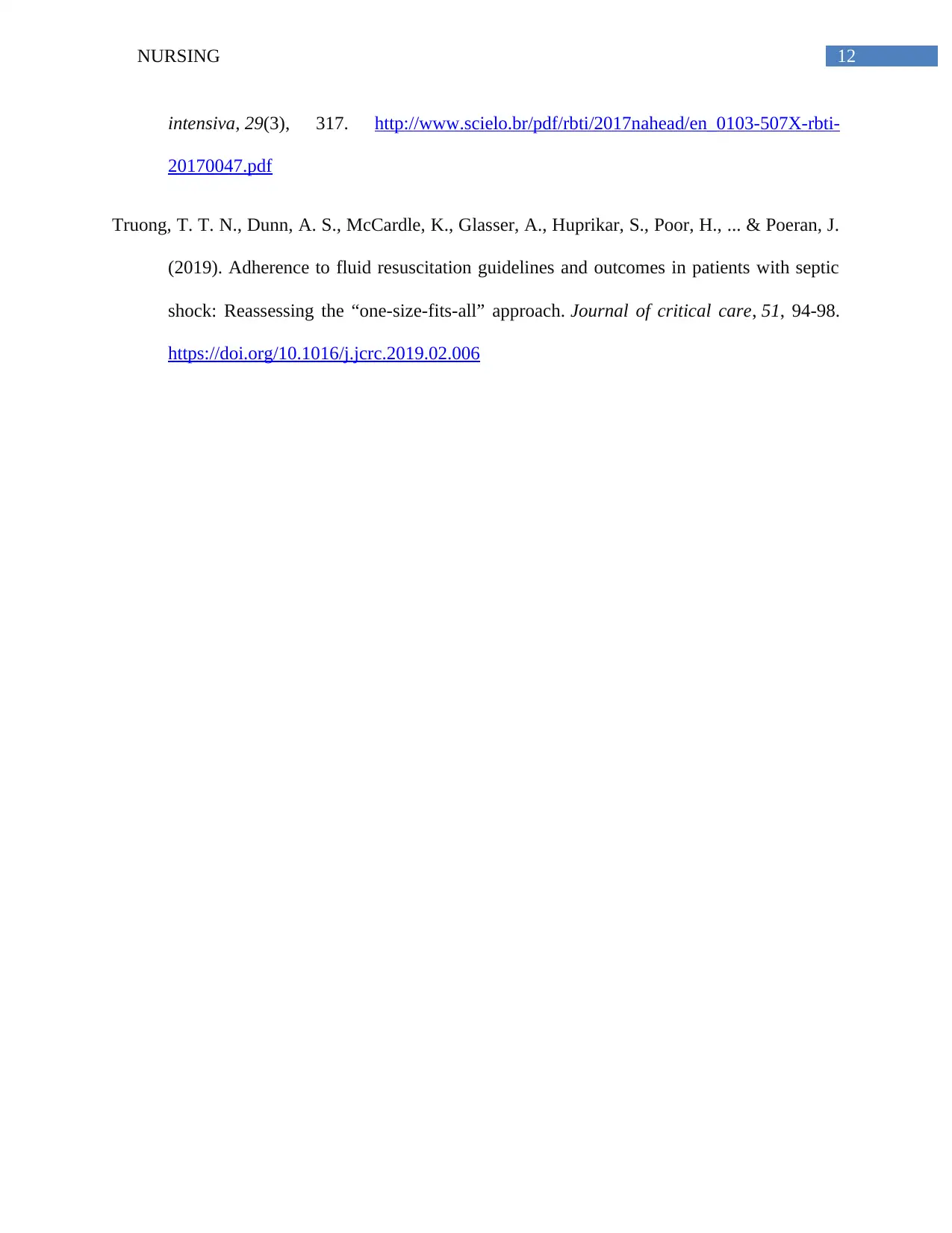
12NURSING
intensiva, 29(3), 317. http://www.scielo.br/pdf/rbti/2017nahead/en_0103-507X-rbti-
20170047.pdf
Truong, T. T. N., Dunn, A. S., McCardle, K., Glasser, A., Huprikar, S., Poor, H., ... & Poeran, J.
(2019). Adherence to fluid resuscitation guidelines and outcomes in patients with septic
shock: Reassessing the “one-size-fits-all” approach. Journal of critical care, 51, 94-98.
https://doi.org/10.1016/j.jcrc.2019.02.006
intensiva, 29(3), 317. http://www.scielo.br/pdf/rbti/2017nahead/en_0103-507X-rbti-
20170047.pdf
Truong, T. T. N., Dunn, A. S., McCardle, K., Glasser, A., Huprikar, S., Poor, H., ... & Poeran, J.
(2019). Adherence to fluid resuscitation guidelines and outcomes in patients with septic
shock: Reassessing the “one-size-fits-all” approach. Journal of critical care, 51, 94-98.
https://doi.org/10.1016/j.jcrc.2019.02.006
1 out of 13
Related Documents
Your All-in-One AI-Powered Toolkit for Academic Success.
+13062052269
info@desklib.com
Available 24*7 on WhatsApp / Email
![[object Object]](/_next/static/media/star-bottom.7253800d.svg)
Unlock your academic potential
© 2024 | Zucol Services PVT LTD | All rights reserved.





